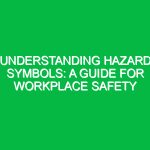Introduction
Hazard symbols are visual indicators that communicate important safety information regarding the risks associated with various substances and situations. For Health, Safety, and Environment (HSE) professionals, these symbols are critical tools that aid in the identification and management of hazards in workplaces, laboratories, and public areas. Recognizing these symbols is not merely an academic exercise; it’s a fundamental aspect of ensuring safety and compliance in various environments.
In our everyday lives, we encounter numerous hazard symbols—on cleaning products, chemicals, and even on the roads. Each symbol carries a specific meaning, designed to warn us of potential dangers, whether they are chemical, biological, or physical in nature. This article delves into the world of hazard symbols, their significance, associated risks, safety precautions, and the regulatory frameworks that govern their use.
Understanding Hazard Symbols
What Are Hazard Symbols?
Hazard symbols are graphical representations that indicate the nature of the risks posed by chemicals, materials, or situations. They are part of a broader system of labeling that includes additional information such as hazard statements, precautionary measures, and product identifiers. Understanding these symbols is vital for anyone involved in HSE practices, as they form the basis of risk assessment and communication across various industries.
These symbols can be found on Material Safety Data Sheets (MSDS), chemical containers, and safety signage. For instance, a simple skull and crossbones symbol warns of toxicity, while a flame symbol indicates flammability. Familiarity with these symbols can significantly enhance workplace safety and compliance.
The Importance of Hazard Symbols in HSE
For HSE professionals, hazard symbols serve multiple purposes. They not only inform employees about potential risks but also play a critical role in regulatory compliance. By understanding and utilizing these symbols, professionals can create safer workplaces, develop effective training programs, and ensure that all employees recognize and respond appropriately to hazards.
A personal anecdote that highlights the importance of hazard symbols comes from a chemical manufacturing plant where I once worked. An employee, unfamiliar with the hazard symbols, mistakenly handled a container marked with a corrosive symbol without proper protective equipment. Fortunately, the quick intervention of a trained colleague prevented serious harm. This incident underscored the vital role of hazard symbols in preventing accidents and saving lives.
Types of Hazard Symbols and Associated Risks
Understanding the different types of hazard symbols and their meanings is crucial for effective risk management. Below are some common categories of hazard symbols, along with their descriptions and associated risks.
Chemical Hazards
Chemical hazards are represented by symbols that indicate the nature of a chemical’s potential risks. Common symbols include:
– **Flame**: Indicates flammable materials. Risks include fire and explosion.
– **Skull and Crossbones**: Indicates toxic substances. Risks include poisoning and health complications.
– **Corrosion**: Indicates materials that can cause skin and eye damage or corrode metals. Risks include chemical burns and property damage.
Understanding these symbols is essential for proper handling, storage, and disposal of chemicals. For example, the use of the flame symbol on a fuel container warns users to keep it away from open flames and heat sources.
Physical Hazards
Physical hazards encompass risks that arise from physical conditions or materials. Relevant symbols include:
– **Exploding Bomb**: Indicates explosive materials. Risks include detonation and severe injury.
– **Radiation**: Indicates radioactive materials. Risks include radiation exposure and contamination.
These symbols help in mitigating risks related to physical dangers. For instance, the presence of an exploding bomb symbol ensures that appropriate safety measures, such as distance and protective gear, are in place when handling explosive materials.
Biological Hazards
Biological hazards are represented by symbols indicating the presence of pathogens or biological materials that pose health risks. The common symbol in this category is the biohazard symbol, which signifies materials that could cause infection or disease.
Risks associated with biological hazards include exposure to infectious agents, which can pose serious health threats to employees, particularly in healthcare and laboratory settings. Proper training and use of personal protective equipment (PPE) are critical in protecting workers from these risks.
Safety Precautions and Best Practices
Once hazard symbols are understood, it is essential to implement safety precautions to mitigate the associated risks effectively. Here are some best practices for HSE professionals:
Comprehensive Training Programs
Every employee should undergo training that covers the meanings of hazard symbols and the corresponding risks. Training should include practical scenarios where employees can recognize and respond to hazards. Regular refresher courses are also essential to ensure that knowledge remains current.
Utilization of Personal Protective Equipment (PPE)
PPE is critical in minimizing exposure to hazards. Depending on the nature of the risk indicated by the hazard symbols, appropriate PPE may include gloves, goggles, respirators, or full-body suits. For instance, when working with corrosive substances, employees should wear chemical-resistant gloves and face shields to prevent skin and eye contact.
Clear Labeling and Signage
Ensuring that all hazardous materials are clearly labeled with appropriate hazard symbols is crucial. This includes not only chemical containers but also areas where hazardous materials are stored or used. Signage should be positioned in visible locations to reinforce safety messages.
Emergency Preparedness Plans
An effective emergency preparedness plan should include procedures for responding to incidents involving hazardous materials. This plan should be communicated to all employees and include regular drills to ensure everyone knows their roles in an emergency.
Regulations and Standards Governing Hazard Symbols
Several regulations and standards govern the use of hazard symbols, ensuring consistency and safety across industries. Understanding these regulations is vital for compliance and effective risk management.
Globally Harmonized System (GHS)
The GHS is an international standard for classifying and labeling chemicals. It aims to ensure that information about chemical hazards is communicated consistently worldwide. The system includes specific hazard symbols, signal words, and precautionary statements, all designed to enhance safety and reduce confusion.
Occupational Safety and Health Administration (OSHA)
In the United States, OSHA regulates workplace safety and health through standards that often reference hazard symbols. Employers are required to provide employees with information about the hazards they may encounter and to ensure that appropriate safety measures are in place.
Environmental Protection Agency (EPA)
The EPA oversees regulations concerning hazardous waste and chemicals that impact environmental health. This includes guidelines on labeling and managing hazardous substances, ensuring that hazard symbols are used correctly to protect both human health and the environment.
Conclusion
Understanding hazard symbols is not just about recognizing a symbol on a label; it is about fostering a culture of safety within organizations. For HSE professionals, these symbols are invaluable tools for risk communication and management. By being well-versed in the meanings and implications of various hazard symbols, professionals can take proactive steps to enhance workplace safety and compliance.
Incorporating comprehensive training, using appropriate protective measures, and adhering to regulatory standards are essential strategies in mitigating risks associated with hazardous materials. As we navigate the complexities of safety in our work environments, let us remember the critical role that hazard symbols play in safeguarding our health and well-being.


